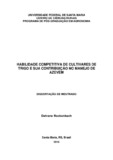| dc.creator | Rockenbach, Dalvane | |
| dc.date.accessioned | 2017-05-02 | |
| dc.date.available | 2017-05-02 | |
| dc.date.issued | 2014-08-15 | |
| dc.identifier.citation | ROCKENBACH, Dalvane. Competitive ability of wheat cultivars and their contribution in the management of ryegrass. 2014. 105 f. Dissertação (Mestrado em Agronomia) - Universidade Federal de Santa Maria, Santa Maria, 2014. | por |
| dc.identifier.uri | http://repositorio.ufsm.br/handle/1/5125 | |
| dc.description.abstract | Three experiments were conducted in 2012, two in the field and one in the greenhouse with the objective of identifying the competitive potential of different wheat cultivars. The field experiments were conducted in Cruz Alta, RS and Vacaria, RS in the absence and presence of competition with ryegrass. In the greenhouse the wheat cultivars were sown in pots to evaluate initial growth. 2013 Cruz Alta, RS two experiments were conducted using contrasting cultivars related to the competitive potential defined in the experiments of 2012. This experiment had the purpose of evaluating the contribution of the competitive potential in chemical control of ryegrass. Five managements of ryegrass, control, weeded, herbicide application iodossulfuron-methyl at a dose of 5 g ha-1 at the beginning of tillering, herbicide application 15 days and 30 days after the start of tillering were used. Plant characteristics such as plant height, dry matter of shoots, ground cover, potential competitive ability and yield losses due to the competition, in addition to the suppression ability of the ryegrass indicate that the cultivar BRS 327 has high competitive potential with ryegrass and the variety OR 1 has the lowest competitive potential among the tested cultivars. The higher competitive potential of the cultivar BRS327 related to OR1, did not serve as an auxiliary tool in the management of ryegrass. The higher competitive potential of the cultivar Fundacep 47 compared to Fundacep 30 served as an auxiliary tool in the management of ryegrass. | eng |
| dc.format | application/pdf | por |
| dc.language | por | por |
| dc.publisher | Universidade Federal de Santa Maria | por |
| dc.rights | Acesso Aberto | por |
| dc.subject | Lolium multiflorum | por |
| dc.subject | Supressão | por |
| dc.subject | Redução na produtividade | por |
| dc.subject | Controle cultural | por |
| dc.subject | Controle químico | por |
| dc.subject | Lolium multiflorum | eng |
| dc.subject | Suppression | eng |
| dc.subject | Reduction in productivity | eng |
| dc.subject | Cultural control | eng |
| dc.subject | Chemical control | eng |
| dc.title | Habilidade competitiva de cultivares de trigo e sua contribuição no manejo de azevém | por |
| dc.title.alternative | Competitive ability of wheat cultivars and their contribution in the management of ryegrass | eng |
| dc.type | Dissertação | por |
| dc.description.resumo | Foram conduzidos três experimentos no ano de 2012, dois a campo e um em casa de vegetação com o objetivo de identificar o potencial competitivo de diferentes cultivares de trigo. Os experimentos a campo foram conduzidos em Cruz Alta, RS e Vacaria, RS, na ausência e presença da competição com o azevém. Em casa de vegetação os cultivares de trigo foram semeados em vasos para avaliar o seu crescimento inicial. No ano de 2013, em Cruz Alta, RS, foram conduzidos dois experimentos utilizando cultivares contrastantes quanto ao potencial competitivo definidos nos experimentos de 2012. Este experimento teve o objetivo de avaliar a contribuição do potencial competitivo no controle químico do azevém. Foram utilizados cinco manejos de azevém, testemunha sem controle, testemunha capinada, aplicação de herbicida iodossulfuron-methyl na dose de 5 g ha-1 no início do afilhamento, aplicação do herbicida 15 dias e 30 dias após o início do afilhamento. As características das plantas, como estatura, matéria seca da parte aérea, cobertura do solo, habilidade competitiva potencial e perdas na produtividade em função da competição, além da capacidade de supressão do azevém indicam que o cultivar BRS 327 tem alto potencial competitivo com o azevém e que o cultivar OR 1 tem o menor potencial competitivo entre os cultivares testados. O maior potencial competitivo do cultivar BRS327 em relação a OR1, não serviu de ferramenta auxiliar no manejo do azevém. O maior potencial competitivo do cultivar Fundacep 47 em relação ao Fundacep 30 serviu como ferramenta auxiliar no manejo do azevém. | por |
| dc.contributor.advisor1 | Marchezan, Enio | |
| dc.contributor.advisor1Lattes | http://lattes.cnpq.br/2740617028203037 | por |
| dc.contributor.referee1 | Machado, Sérgio Luiz de Oliveira | |
| dc.contributor.referee1Lattes | http://lattes.cnpq.br/0360886006002113 | por |
| dc.contributor.referee2 | Schaedler, Carlos Eduardo | |
| dc.contributor.referee2Lattes | http://lattes.cnpq.br/4863775080485915 | por |
| dc.creator.Lattes | http://lattes.cnpq.br/0133605113838006 | por |
| dc.publisher.country | BR | por |
| dc.publisher.department | Agronomia | por |
| dc.publisher.initials | UFSM | por |
| dc.publisher.program | Programa de Pós-Graduação em Agronomia | por |
| dc.subject.cnpq | CNPQ::CIENCIAS AGRARIAS::AGRONOMIA | por |


